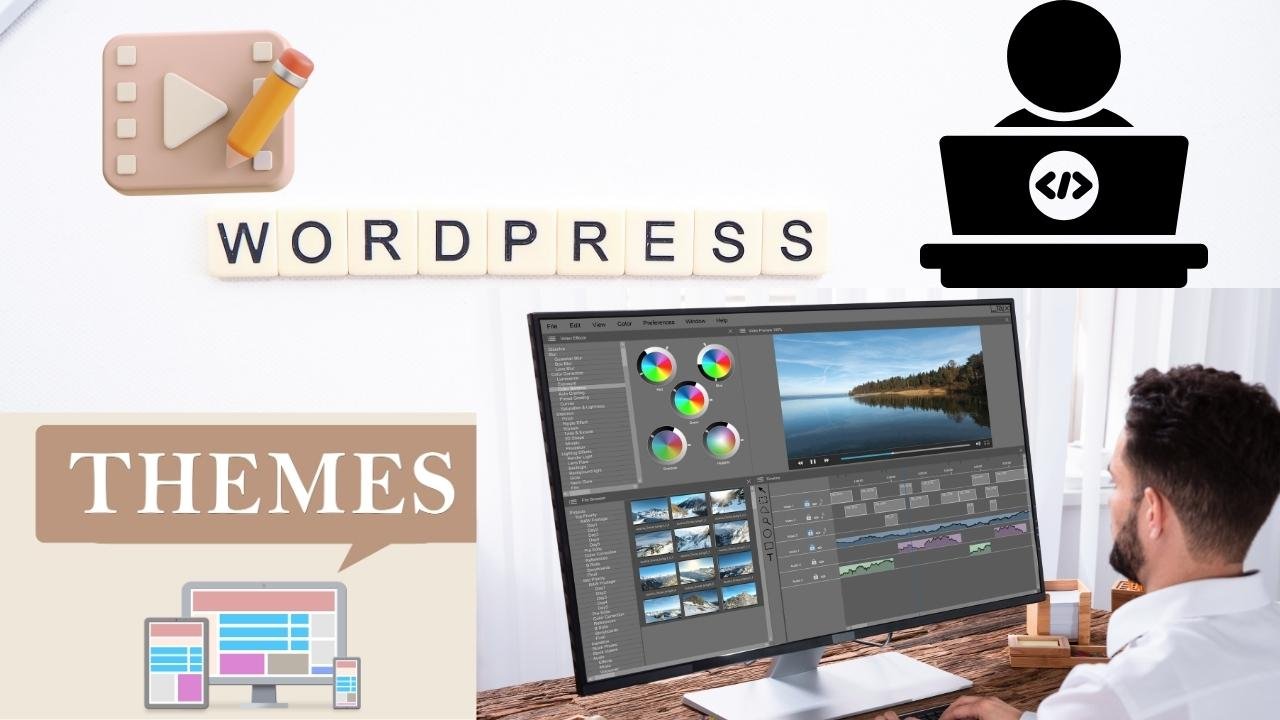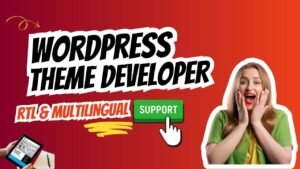Discover the key differences between Classic and Block Themes in WordPress 2025. Learn how Full Site Editing (FSE), theme.json, and block patterns are changing theme development and which approach best suits modern developers.
Introduction
The WordPress ecosystem is going through one of the most significant transitions in its history. The introduction of Full Site Editing (FSE) and Block Themes has completely changed how themes are designed, developed, and customized.
For years, Classic Themes dominated the landscape — built with PHP templates, widget areas, and the Customizer. But with the evolution of Gutenberg, the new Block Theme architecture gives developers visual editing power, performance boosts, and an entirely new design workflow.
So, the question in 2025 is clear: Should you still build Classic Themes, or is it time to go all-in on Block Themes?
Let’s break down the differences, pros, and future of both.
1. What is a Classic Theme?
Classic Themes are the traditional WordPress themes we’ve known for years. They rely on
- PHP template files (header.php, footer.php, single.php)
- The Customizer for global options
- Functions in functions.php for theme features
- Widget areas and menus for layout customization
Example
Themes like Astra, GeneratePress, and OceanWP are well-known Classic Themes. They are stable, widely supported, and compatible with most page builders like Elementor and WPBakery.
🔹 Key Components of a Classic Theme
-
PHP-based templates (no block JSON structure)
-
Customizer for styling & global settings
-
Widgets and Menus for navigation
-
Theme Options pages (sometimes built with frameworks)
2. What is a Block Theme?
Block Themes, introduced in WordPress 5.9 and expanded in 6.x, are built entirely with the Block Editor and Full Site Editing (FSE).
Instead of PHP templates, they use HTML files containing Gutenberg blocks. Every part of your site — header, footer, post template — is editable visually.
🔹 Key Components of a Block Theme
-
HTML templates instead of PHP templates
-
theme.json for global design settings
-
Template Parts & Patterns for reusable layouts
-
Site Editor replaces the Customizer.
Example
Themes like Twenty Twenty-Four, Blocksy FSE, and Kaddora Multipurpose Block Theme use FSE architecture.
3. Folder Structure Comparison
Aspect | Classic Theme | Block Theme |
Main Templates | PHP files (header.php, index.php) | HTML files (index.html, home.html) |
Global Styles | style.css or Customizer | theme.json |
Customization Tool | WordPress Customizer | Site Editor (FSE) |
Reusable Layouts | Widgets & shortcodes | Patterns & Template Parts |
Page Builders | Elementor, Beaver Builder | Gutenberg only |
Performance | Moderate | Lightweight & faster |
File Extension | .php | .html + .json |
4. The Role of theme.json
In Block Themes, theme.json acts as the heart of the design system. It defines
- Colors, fonts, and typography
- Spacing and layout
- Global styles for blocks
Example
{
“version”: 2,
“settings”: {
“color”: {
“palette”: [
{“slug”: “primary”, “color”:”#198754 “, “name”: “Primary”},
{“sl ug”: “secondary”, “color”:”#212529″, “name: “Dark”}
]
},
“typography”: {
“fontFamilies”: [
{“fontFamily “: “Poppins, sans-serif”, “slug”: “poppins”,” name”:”Poppins”}
]
}
}
}
Developers can now control design tokens globally without writing additional CSS.
5. Developer Experience: PHP vs No-Code Blocks
Classic Theme Devs
- Write PHP loops for posts
- Manually enqueue scripts
- Handle widget registration and hooks.
Block Theme Devs
- Focus more on JSON structure and HTML markup
- Can visually test layouts in the Site Editor
- Less PHP coding, more configuration
Block Themes encourage hybrid workflows, where design and development blend seamlessly.
6. WooCommerce and Compatibility
Classic Themes
- Work with older WooCommerce templates
- Depend on PHP hooks (woocommerce_before_main_content)
- Often need custom styling for block features.
Block Themes
- Use WooCommerce Blocks (product grid, mini cart, checkout)
- Support block templates for single-product.html or archive-product.html
- Faster rendering using React-powered blocks
WooCommerce’s roadmap for 2025 is block-first, meaning Block Themes will get newer features earlier.
7. Performance and Speed
Block Themes generally load faster because
- They use fewer PHP render calls
- Inline styles are generated efficiently through theme.json
- Fewer dependencies on external builders
Classic Themes can still perform well but often rely on large frameworks, extra CSS, and plugins.
8. Customization & Flexibility
Feature | Classic Theme | Block Theme |
Header/Footer Editing | Only via Customizer or PHP | Visual drag-and-drop |
Global Styles | Through Customizer | Managed in Site Editor |
Live Preview | Partial | Full real-time editing |
Block Patterns | Limited | Fully supported |
Template Export | Manual | One-click export |
For clients or non-technical users, Block Themes deliver unmatched flexibility.
9. When to Use Each Theme Type
Choose Classic Theme if
- You need compatibility with older plugins or legacy code
- Your workflow depends on page builders (Elementor, WPBakery)
- You manage websites built before WordPress 6.0
Choose Block Theme if
- You want to leverage FSE and modern WordPress architecture
- You build scalable, performance-optimized WooCommerce stores.
- You want to offer clients no-code customization via the Site Editor.r
Hybrid themes (like “Kaddora Hybrid Multipurpose Theme”) can also combine both systems for maximum flexibility.
10. The Future: Block Themes Take Over
WordPress’s official roadmap confirms that Full Site Editing is the future.
By 2026, most default themes and WooCommerce templates will be block-based.
Classic Themes will still work, but they’ll gradually move into maintenance mode. Developers should start migrating skills toward
- theme.json
- Block patterns
- Global styles
- Template parts
Learning Block Theme architecture now ensures long-term relevance and higher client demand.
Conclusion
The Classic vs Block Theme debate isn’t about choosing one forever—it’s about evolution.
Classic Themes brought stability and flexibility for over a decade. But in 2025, Block Themes represent the next generation—faster, visual, and easier to maintain.
If you’re a WordPress developer, the smartest path is to learn both
- Keep Classic Theme expertise for legacy projects.
- Embrace Block Themes for new, future-ready builds.
The future of WordPress is block-first, and early adopters will lead the next era of theme innovation.
Top 10 FAQs
-
What is the main difference between Classic and Block Themes? Classic Themes use PHP templates and the Customizer, while Block Themes use HTML templates, theme.json, and the Site Editor for visual design.
-
Can I still use Classic Themes in 2025? Yes, Classic Themes are still supported, but new features like Site Editing are exclusive to Block Themes.
-
Are Block Themes faster than Classic Themes? Generally, yes. Block Themes are lighter, optimized for Gutenberg, and reduce reliance on heavy PHP code.
-
What is Full Site Editing (FSE)? FSE allows users to edit every part of their site — including headers and footers — directly in the WordPress editor.
-
Can I convert my Classic Theme to a Block Theme? Yes. You can gradually replace PHP templates with HTML templates and create a theme.json file to define styles.
-
Do Block Themes support page builders like Elementor? Not directly. Block Themes are designed for Gutenberg, though you can still use classic page builders separately.
-
Is theme.json mandatory for Block Themes? Yes. It defines the theme’s design system, including colors, fonts, spacing, and block styles.
-
Are Block Themes good for WooCommerce stores? Absolutely. WooCommerce now provides block-based templates and blocks like Mini Cart, Checkout, and Product Grid.
-
Will Classic Themes stop working in the future? No, but they may stop receiving major updates as WordPress focuses on block architecture.
-
Which is better for developers in 2025? Block Themes are the future — more efficient, visual, and modern. But keeping Classic Theme knowledge ensures compatibility for legacy projects.

Monetising WordPress Themes & Plugins: Licence Models, Free-vs-Pro Strategy & Affiliate Marketing
Read More »
Theme Security Best Practices: Protecting Your Users and Building a Trusted Brand (2025 Edition)
Read More »





Leave a Reply